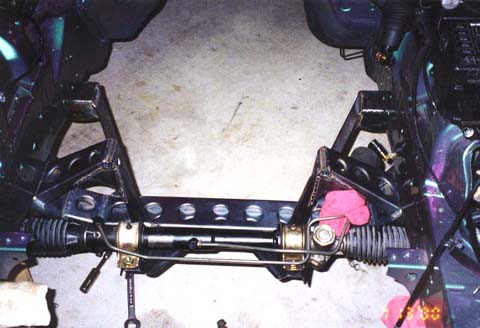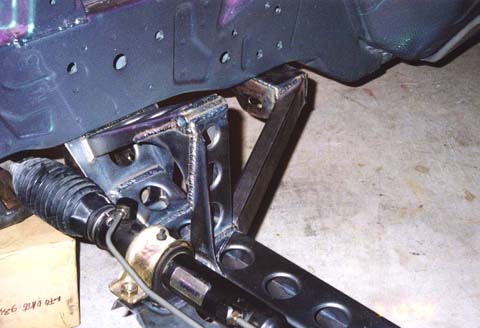
'93-up 3rd gen RX-7 V-8 Conversion Frequently Asked Questions...

'93-up 3rd gen RX-7 V-8 Conversion Frequently Asked Questions...
...how much will all this V-8 stuff weigh down my car ?...
...the finished weight depends on a lot of variables when opting for a Chevy drivetrain. Component choices can vary widely.
Bill Hagen's '94, equipped with a Camaro LT1 (factory equipped with aluminum heads), T56 6spd, AC, PS, oil cooler, cast iron exhaust manifolds and catylitic converter weighs in at 2950lbs with a half tank of fuel, and 50lbs added to the spare tire well. The 50 lbs in the tire well brought the balance to a perfect 50/50 (1475 front / 1475 rear) weight distribution with the 1/2 tank of fuel. This car could also be trimmed out by simply filling up the fuel tank!
Retaining the RX-7's near perfect weight distribution isn't a big problem, but the job is even easier if you build the new powertrain with balance in
mind when choosing/relocating components. The Chevy engine is heavier than the rotary, but by the time you consider
all the rotary specific components you will also remove, the gain is minimal. Solenoids/relays, heat
shields, oil coolers, turbos, intercooler, etc. If the final balance needs fine tuning, it's easy to add a
small amount of weight to the extreme rear of the car to trim it out. Some 1st & 2nd gen RX-7 V-8 conversions have
achieved 50/50 balance by just removing/relocating components and deleting the AC. Considering that the
3rd gen also has turbos and an IC to remove, achieving balance is a piece of cake.
consider this....
If you look at the weight gain from a power/weight stand point, it's easy to realize that you can add some weight as long as you back it
up with enough added power. The RX-7 is the lightest car in it's class, and even with a V-8 swap, you're still going be much lighter than the competition.
We often hear people comparing the '93-'95 RX-7 to the Viper, which is understandable, since both have similar lines and both are about as close to production race cars as good sense will allow. The Viper weighs in at around 3380lbs, while the 3rd gen RX-7 is about 2860 w/ a full tank of fuel, a difference of over 500lbs. The Viper's 520 additional lbs require another 70 HP over that of the RX-7 to maintain the same P/W ratio. This means that you can equal the 450hp Viper GTS's P/W ratio with only 381 HP from your Chevy. You can buy new CRATE ENGINES from Chevy with more power than this !!! ...and get a factory warranty, plus the advantage of qualified network of service technicians from coast to coast.
Considering these facts, it's easy to see that even after balancing a 3rd gen / V-8 conversion, you will still weigh considerably less than the Viper, but can easily have the same or more power. Getting 500 ft/lbs from an SB Chevy is not uncommon, and is very affordable.....also very reliable and easily maintained.
When you choose to convert to Chevy power, you can also easily step up to a 6 spd transmission, the BorgWarner (Tremec) T-56, which is also the gearbox used in the Viper.
...I see this is for the LT1. Do you offer parts to make it possible to use an LS1 ?...
...Yes, but it is not quite as easy. The LS1 powered 3rd gen on our site has had hood modification (cowl style hood). Although we sell the parts required, we do not promote the LS1 install as it requires modifying the hood in order to keep the stock steering rack location, which we feel is important. We have considered a few different ways to fit the LS1 under the stock RX-7 hood, but we feel they all have negative effects on the 3rd gen RX-7's near perfect steering geometry....
...lowering the rack induces bumpsteer.
...lowering the entire subframe lowers the front roll center.
...lowering the rack and outer ti-rod ends properly requires a narrower steering rack.
And last but not least...lowering the LS1 for stock hood clearance drastically reduces your ground clearance!!! Your cast aluminum oilpan will be the lowest point, and can be quite easily damaged if it bottoms out or is struck by road debris. For this reason alone, we prefer our "higher" engine location for the LS1, even for track cars! Think of it this way...If you install a LS1 (stock F-body pan) under the stock RX-7 hood, your car's ride height will be dictated by how brave you are regarding your oilpan's ground clearance. For a given oilpan/ground clearance, our "higher" engine location allows the rest of your entire chassis to sit 1-1/2" lower, resulting in a LOWER center-of-gravity overall when compared to the optional hood-clearing "lower" engine location. Think of our "higher" engine placement as lowering the rest of your car around the engine.
The typical scheme used to REDUCE (does not eliminate) bump steer when lowering the rack for installing a LS1 into a 3rd gen RX-7 is to drop the outer ti-rod ends with an extended stud and race car style rod ends in place of the outer ti-rod end. We feel this set-up is less than optimal for a street car, as this type of rod end quickly develops slop as they wear, and do not have a pre-loaded design like the OEM ti-rod end to compensate. Another aspect to ponder is that some might consider the race car style rod end to be un-safe or even illegal to be used in this manner on a street car, as it's design allows a worn rod end to fall apart resulting in loss of control. The extended studs used to lower this type of rod end also induces an increased twisting force on the spindle's steering arm, which results in a car that is somewhat easier to knock out of steering alignment when introduced to curbs and potholes. While this type of set-up is common on race cars, even our own, we do not feel it is appropriate for the street. We doubt that any insurance company would knowingly cover a car used on public highways with such a mis-application of steering components.
Converting to a 2nd gen manual rack in your 3rd gen RX-7 allows a lower engine position and buys you some room at the hood, but it is not quite enough. The cast aluminum LS1 oil pan interferes with the rack clamping brackets for the 2nd gen rack. Modifying a used cast aluminum oil pan is very difficult, as the oil in the pores of the metal is near impossible to remove.
Just to be clear, our LS1/3rd gen conversion DOES NOT lower the steering rack or require any bump steer correction. Because our LS1 mounting position DOES NOT require a lowered steering rack location, it DOES require hood modification for engine clearance in the area of the throttle body.
We use the same fabricated subframe for both the LT-1 and LS1 conversion, allowing an easy switch from one to the other without requiring purchase or replacement of a new subframe.
...can I use a regular Small Block Chevy ?...
......If you would like to install a generic Small Block Chevy into your 3rd gen RX-7, a distributorless ignition system will be required (Electromotive makes a good one) to avoid firewall modification. Point of referance: if you look down from above across the plane of the firewall, our Chevy V-8 engine location in the 3rd gen RX-7 centers the distributor hole with the plane of the firewall.
...won't a V-8 have a higher center of gravity than a rotary ?...
......Another parameter typically debated "rotary vs. V-8" is CG height. Many believe the V-8 with it's higher heads and intake manifold raise the CG height and
must ruin the handling. Our response is that things are not as they may seem.
The engine/trans should be considered as a package. The rotary's appx 6"
higher eccentric shaft centerline and resulting higher transmission location
all but eliminates any advantage the smaller rotary engine is thought to
benefit from. We doubt the CG of the engine/trans package, as installed in an RX-7, is that different. An LS1, with it's aluminum block, aluminum heads, and plastic intake manifold, may even have an advantage over the rotary with regards to CG height.
...can I use a Ford 5.0 ?...
......Unfortunatly, the Ford 5.0's oil pump is at odds with the RX-7's steering rack location. The best solution would be radical firewall surgery, but we do not feel this is practical for the typical conversion.
...can I use a Ford 4.6 modular ?...
......In case you have not noticed, the 4.6 is a huge engine. Even in the Ford mid-sized cars such as the ThunderBird, the 4.6 sits ahead of the brake booster. Since fitting the 4.6 into a 3rd gen RX-7 would require either a re-located brake booster or an unreasonably forward engine location, we do not offer parts for the conversion.
...so what if I want to convert my RX-7 to V-8 power too ?...
......You can contact us, by phone or e-mail, with any questions you might have about converting your car or placing your order.


Off the shelf Chevy mounts are used, which are also available from Energy Suspension in polyurethane.
Tach signal ratio adapter............Dakota Digital PN# SGI-5/tach ($100.) Speedometer ratio adapter............Dakota Digital PN# SGI-5 ($79.)